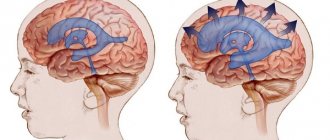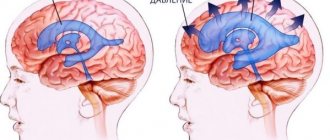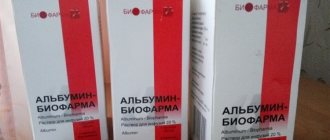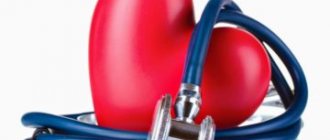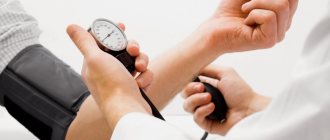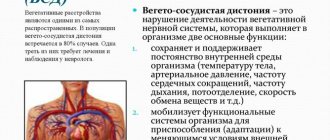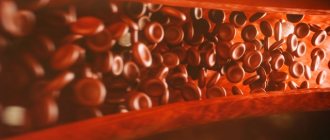November 23, 2016
Averyanova Sveta
Sleep disturbances, moodiness, and anxiety can be a consequence of a diagnosis such as intracranial pressure in a child.
In order to help him cope with this, parents should regularly visit the pediatrician, not keep silent about what is bothering the baby, and follow all the recommendations that follow from the doctor.
After all, the consequences of this change in the body can cause serious problems that can darken the child’s future, and even make him disabled.
Normal indicators
ICP is a quantitative indicator that reflects the force of action of spinal cord fluid on its tissue. The normal intracranial pressure is presented in the table.
Table 1. Normal indicators:
| Age | Minimum value (mm.r.st.) | Maximum value (mmHg) |
| 1,5 | 6 |
| 1,5 | 6 |
| 3 | 7 |
| 3 | 7 |
| 100 | 180 |
When should you not worry?
Increased blood pressure is often the body's natural response to stress.
High intracranial pressure does not always signal the development of a serious illness.
A short-term increase in indicators is often observed in everyday life, with:
- bowel movements;
- stress;
- cough;
- sneezing;
- laughter;
- sucking the mother's breast.
Treatment is required for frequently increasing ICP.
Why are the numbers increasing?
What causes this condition? The main causes of increased intracranial pressure are presented in the table.
Table 2. Provoking factors:
| Cause | Factor |
| An increase in ICP is provoked by the appearance of additional tissue. As a result, brain structures change. |
| Blood pressure increases when the cancer tumor is actively growing. |
| The provocateur is a change in the structure of the cerebrospinal fluid. |
| An increase in ICP is provoked by an inflammatory process that affects brain tissue. |
| The pressure increases due to the lack of normal circulation of cerebrospinal fluid. |
| The provocateur is cerebral edema. |
| The pressure increases due to compression of the brain tissue. |
| ICP rises due to simultaneous growth of the brain. |
Note! In children, in 85% of cases, an increase in ICP is caused by intrauterine infection or trauma received during childbirth.
Diagnostics
Intracranial hypertension syndrome must be diagnosed in several ways.
Medical history and medical examination
It is critical that the physician review the patient's complete medical history and perform a thorough physical examination to understand the onset of symptoms and their relationship to any existing or past medical problem, and to determine the presence of any underlying risk factors.
Ophthalmoscopic examination
Then, as a next step, the doctor will examine the child's eyes using an ophthalmoscope to check if there is swelling in the optic disc or if there are any additional blind spots.
Visual methods
This is followed by a detailed neurological examination using various visual diagnostic methods, namely:
- magnetic resonance imaging (MRI);
- computed tomography (CT) scan to determine the cause and extent of the problem, such as the appearance of a tumor or the presence of blood clots in the vessels.
- The most highly informative research method in children under one year of age (when the fontanelles are still open) is neurosonography. This is an ultrasound of the child's brain.
Lumbar puncture
A lumbar puncture may be needed to check cerebrospinal fluid pressure and evaluate glucose and protein levels.
Features of the clinical picture
One of the signs of serious problems in the body is severe weakness.
How does increased intracranial pressure manifest?
Doctors identify the following symptoms:
- blue circles under the eyes;
- swelling of the nerve of one of the organs of vision;
- fast fatiguability;
- impaired ocular reaction;
- anger;
- decreased peripheral vision;
- frequent presyncope;
- decreased central vision;
- increased sweating;
- decreased blood pressure;
- headache;
- swelling of the eyelids.
Your head may hurt after waking up. This symptom is accompanied by a feeling of “brokenness.”
Signs in children over 3 years old
The main symptoms in children of three years of age are presented in the table.
Table 3. Signs of high intracranial pressure in children over 36 months:
| Sign | Description |
| Associated with vomiting. There is no relief. |
| The pain syndrome is caused by the pressure of the cerebrospinal fluid on the areas behind the eye sockets. |
| Against the background of irritation of the optic nerves, specific flashes may simultaneously appear in front of the organs of vision. |
| The intensity increases in the evening and at night. |
| The symptom is combined with irritability and tearfulness. |
Signs in infants
The main sign of increased ICP in young children is excessive crying. This symptom is combined with anxiety.
Table 4. Symptoms of high cranial pressure in infants:
| Sign | Description |
| The baby often wakes up, sleeps poorly and has difficulty falling asleep. |
| The symptom is caused by irritation of the centers of the medulla oblongata. |
| The provocateur of this condition is the accumulation of cerebrospinal fluid in the liquor spaces. |
| The blood in the subcutaneous veins stagnates, against this background they become visible. |
| Occurs due to birth trauma. |
| The physiological increase in ICP during sucking is accompanied by headache. By refusing to eat, the baby loses weight. |
| The psycho-emotional sphere suffers. The symptom is due to pressure on the brain. |
Prevention
Breastfeeding is a good prevention of such pathology in babies.
High blood pressure in a child is treated and prevented using measures such as:
- regular walks in the air;
- positive atmosphere;
- surrounding the child with love, affection and attention;
- proper nutrition, enriched with vitamins and minerals;
- breast-feeding.
To prevent the occurrence of congenital changes, it is necessary to undergo a thorough examination and appropriate treatment during pregnancy planning. You should also protect the expectant mother from stressful situations, take enough vitamins and monitor your health.
Pressure measurement
Intracranial pressure can be measured using a special catheter. It is injected into the lateral ventricle of the brain. This method is considered the most accurate.
Note! Blood pressure should only be measured in exceptional situations.
Diagnosis of intracranial pressure in children begins with examination of the fundus.
Then the specialist directs the patient to undergo:
- Ultrasound of the brain;
- CT;
- echoencephalography;
- MRI.
A spinal puncture is performed to measure average cerebrospinal fluid pressure.
A child has intracranial pressure - what is it?
Intracranial pressure is an increase or decrease in the volume of cerebrospinal fluid (cerebrospinal fluid, which is located in the subdural space between the membranes of the brain) inside the skull. But ICP in children is not an independent disease, but only a symptom of some pathology in the body.
If increased ICP is permanent and there are disturbances in the physical or mental development of the child, it is necessary to contact a therapist or pediatric neurologist and not let the disease take its course.
How can you help?
A set of exercise therapy exercises can help cope with high blood pressure
What should you do if you notice alarming symptoms? It is recommended to seek medical help as soon as possible.
Intracranial pressure can be relieved using both medications and the following methods:
- manual therapy;
- exercise therapy;
- invasive procedures.
Carrying out additional therapy improves the general condition of the patient and relieves him of many symptoms.
Complications and prognosis
If help for a child with ICP is not provided in a timely manner, this is fraught with the following consequences:
- the baby is significantly behind in mental and anatomical development;
- hydrocephalus develops;
- The child constantly screams and is capricious.
If, from the moment of birth, parents carefully monitor the behavior of their baby, and if deviations are detected, they promptly seek advice from specialists, the prognosis is positive in the overwhelming majority. High blood pressure in a baby returns to normal, and the formation of basic systems and organs is not disrupted.
Features of drug therapy
How to relieve increased intracranial pressure?
The patient is prescribed the use of drugs from the following groups:
- diuretics;
- sedatives;
- antiarrhythmic;
- nootropic;
- eliminating cognitive impairment.
One of the most effective drugs for intracranial pressure in adults is Diacarb.
Use of diuretics
Such medications help remove excess fluid from the kidneys. At the same time, the pressure of the cerebrospinal fluid decreases.
Table 5. The most effective diuretics for intracranial pressure:
| A drug | Description | Price | How to use? |
| Carbonic anhydrase inhibitor. | 246 rubles. | How to take Diacarb for intracranial pressure? The dosage and regimen of medication are determined individually. The maximum effect is achieved when the drug is taken 1 time/24 hours, every 24-48 hours, with a daily break. |
| Has a dehydrating, dermatoprotective, laxative effect. | 158 rubles. | After meals, 1 time per day. |
| A “loop” diuretic that causes rapid, powerful and short-term diuresis. | 20 rubles. | 1 tablet before meals. Daily dosage – 1500 g. |
Use of sedatives
Medicines in this group have a hypotensive effect. Their use has a beneficial effect on the psycho-emotional state of the patient.
Table 6. Sedative medications to reduce intracranial pressure:
| Medicine | Description | Price |
| It has an anxiolytic, sedative, anticonvulsant, and central muscle relaxant effect. | 620 rubles |
| Combined herbal medicine that has a sedative effect. | 219 |
| Anxiolytic drug. Has a sedative and anticonvulsant effect. | 81-315 rubles. |
Use of antiarrhythmic drugs
These drugs for lowering intracranial pressure help optimize blood circulation in the brain.
Table 7. The best antiarrhythmic drugs:
| A drug | Description |
| Improves cerebral and peripheral blood circulation. |
| Has a cerebroprotective effect. |
| Calcium channel blocker. |
| Alpha adrenergic blocker. Promotes activation of brain metabolism. |
The drug "Sermion" is available in different forms. Prices in rubles for this medicine are indicated in the chart.
The cost of the medicine varies from 456 to 1664 rubles
Use of nootropics
The best nootropic drugs for increased intracranial pressure are presented in the table.
Table 8. The best Tablets for intracranial pressure in adults:
| Medicine | Description | Price |
| Helps facilitate various types of synaptic transmission. | 261 rubles |
| Has an anticonvulsant effect. | 900 rubles. |
| It has a beneficial effect on metabolic processes and blood circulation in the brain. | 22 rubles. |
| It has neurometabolic, neuroprotective and neurotrophic effects. | 384 rubles. |
Note! Drugs in this group are prescribed only when it is necessary to influence the body with neurometabolic stimulants.
Addressing Cognitive Impairment
Medicines in this group improve memory and increase mental performance.
Table 9. Tablets for intracranial pressure in adults that improve brain function:
| Medicine | Description | Price |
| The medicine helps with headaches. | From 105 rubles. |
| General tonic drug. Recommended for arterial hypertension. | From 100 rubles. |
When trying to normalize ICP, it is important not to overdo it. Low intracranial pressure can contribute to stroke.
Treatment of intracranial pressure with medications
To normalize intracranial pressure, the following groups of medications are used:
- Nootropic drugs - stimulate mental activity and normalize blood circulation. These include Pantogam, Piracetam, Cavinton and other drugs.
- Diuretics - remove excess fluid from the body (including cerebrospinal fluid). These include Furosemide, Triampur, Diakarb, Veroshpiron, etc.
- Antibiotics - used to fight infectious diseases caused by bacteria, viruses, fungi and protozoa. These include Ceftriaxone, Penicillin, Azithromycin, Amoxiclav, etc.
- Neuroprotectors - calm the nervous system, protect brain cells from various damages, prevent their death and improve their functioning. Among them, the most effective are Glycine, Nervohel, etc.
- Sedatives - normalize the child’s mental state, restore the functions of the nervous system (Persen, Afobazol, etc.).
Giving a child any medications without the consent of the attending physician is strictly not recommended (since the drug can aggravate the baby’s condition). The doctor will select the required dosage and prescribe a course of therapy.
How to help children?
Parents of small children should take them for walks more often and arrange for them to sleep in the fresh air
Can intracranial pressure be treated in a child? If you consult a specialist in a timely manner, the prognosis is favorable. The choice of therapeutic tactics depends on the disease that is caused by an increase in ICP.
Instructions for the treatment of intracranial pressure in children are as follows:
- Normalize the rest and feeding regime. The child should eat and sleep at the same time.
- Take long walks. Their duration varies from 60 to 180 minutes. It is useful for young children not only to play, but also to sleep in the fresh air.
- Give the child medications prescribed by the doctor for treatment. Children are prescribed nicotinic acid, Cavinton.
- Undergo physiotherapeutic treatment.
The operation is performed only for neoplasms and anatomical abnormalities.
Diagnostic methods
How to determine that a child’s ICP has changed? First of all, you need to consult a neurologist. After a thorough questioning and examination, the doctor will prescribe instrumental studies and consultations with related specialists as necessary.
The following diagnostic techniques can be used:
- Neurosonography is an ultrasound examination of the child’s brain, which is carried out through an open fontanel. This technique is informative only until the fontanelle closes.
- Magnetic resonance and computed tomography - which will allow you to assess the presence and level of changes in the structures of brain tissue, determine the presence of neoplasms, and identify changes in the lumen of the pathways through which cerebrospinal fluid is excreted.
- X-ray examination - determines structural anomalies of the skull bones.
- Dopplerography is a study of the condition of the blood vessels of the brain.
- Lumbar puncture is a technique for examining cerebrospinal fluid that allows you to accurately determine changes in ICP. But before checking the indicators of this study, a full range of other procedures are prescribed, and only if they prove unsuccessful is a puncture prescribed.
- Method of direct measurement of pressure inside the skull - how ICP is measured using this method: a needle with a pressure gauge must be inserted into the baby’s head, which will allow you to obtain accurate pressure values and compare them with normal ones.
In some cases, intracranial pressure is determined in a child after a visit to an ophthalmologist, since a prolonged increase in ICP causes changes in the fundus of the eye - dilation of the lumen of the veins and narrowing of the arteries, swelling of the eye disc appears.
The best alternative medicine
Treatment with tablets can be supplemented with traditional medicine.
Table 10. Use of folk remedies:
| Means | How to cook | How to use | How many times to use (24 hours). |
| Squeeze the juice of 1 lemon, combine with 2 tbsp. l liquid honey, pour in 100 ml of cooled boiling water, mix well. | The drug is taken orally, 100 ml, between meals. | 2-3. Treatment should last 3 weeks. |
| Boil 25 g of plant branches in 1000 ml for 30 minutes. | 1 glass before meals. | 1-3. |
| Combine 50 grams of pollen with 25 g of liquid honey, leave for 3 days away from ultraviolet rays. | The product is used for head massage. It is rubbed portionwise into the back of the head, neck and bridge of the nose. Then you need to wrap your head with thick cloth. | 1.The procedure is carried out before bedtime. Treatment lasts 30 days. |
| 3 tsp. Combine dry raw materials with 500 ml of boiling water. Leave for half an hour. | The infusion is taken orally, 50 ml. | 3. |
| Combine 200 grams of fresh inflorescences with 1000 ml of vodka. Leave for 14 days. | Combine 15 ml of tincture with 170 ml of warm water and drink before meals. | 1. |
Note! It is not recommended to treat children with folk remedies.
Dietary recommendations
How to lower cranial pressure with diet?
The nutritional principles look like this:
- you need to have dinner 4 hours before bedtime;
- daily water requirement – 1.5 l;
- number of meals per day – 5-6.
The diagram shows the daily intake of useful elements (g).
Particular attention should be paid to vegetable proteins and fats
The plate indicates the products that are recommended to be included in the menu.
Table 11. What you can eat:
| What is? | Nuances |
| Must be liquid. You can add low-fat sour cream or lean mayonnaise. |
| It is recommended to bake or boil. |
| The vegetable should be baked. Can be used in baking. |
| They must not contain chocolate. It is advisable to give preference to lollipops. |
| They should be eaten raw. |
Performing gymnastic exercises
The set of exercises is aimed at normalizing blood pressure and returning the body to the desired tone. Before performing them, you should definitely consult your doctor.
Table 12. Gymnastics to reduce intracranial pressure:
| Exercise | How to do it at home? | Number of approaches (24 hours) |
| “Arm yourself” with a cylindrical stick with a diameter of 3-4 cm, place it behind your head, stroke the muscles of the neck and spine. | 4. The total duration of the exercise is 15 minutes. |
| Grasp your head with both hands and press your thumbs onto the bundle of neck muscles. Massage this area clockwise. | 2-3. Total duration – 12 minutes. |
| The movements are performed first from top to bottom, then to the right and left sides. | 2-3. Total duration – 8-10 minutes. |
Note! All exercises are performed at a slow pace. Sudden movements are not allowed.
Possible complications
If left untreated, epilepsy may develop
What is the risk of intracranial pressure?
Possible complications include:
- development of epilepsy;
- blurred vision;
- psychical deviations;
- respiratory dysfunction;
- development of hemorrhagic stroke;
- disorder of consciousness;
- development of ischemic stroke.
